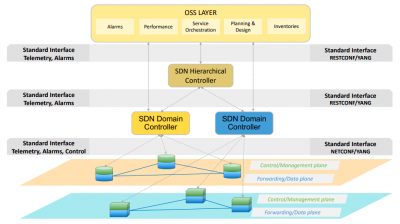5G: SDN IP/MPLS Backbone
Over the past few years all the telecommunications industry actors, including vendors, network service providers, standardization bodies (e.g., IETF, GSMA), and industry fora (e.g., ONF, OIF, OpenConfig, TMForum) have been working toward the habilitation of automatic network control and programmability. Many efforts have been made to make software defined networking (SDN) a reality, hence a large number of architectural frameworks have been proposed. It’s now time to define a common strategy to reduce and select the most suitable standards to unify disparate SDN solutions.
A worldwide, top-ranked network operators group—formed by Telefonica, Vodafone, MTN, Telia Company, DeutscheTelekom, and Orange—has joined efforts to collaborate on open transport SDN within the Telecom Infra Project’s Open Optical and Packet Transport (OOPT) project group. They’ll be leading a new workstream called MUST (Mandatory Use case requirements for SDN for Transport). This white paper presents its common architectural view, the use casebased methodology, and the selection of the most relevant standard interfaces to be implemented by the industry.
The target reference architecture for the transport SDN controllers is hierarchical, with specific domain controllers per technological domain (IP/MPLS, microwave, optical) and a hierarchical controller to provide real-time control of multi-layer and multi-domain transport network resources. The operation support systems (OSS)—including service orchestration and service and resource inventory—will be consuming a set of APIs exposed by the controllers to handle the data and configurations toward end users and enabling service fulfillment.
Based on common use cases defined by the operators, the set of standard SDN interfaces are selected and detailed to produce a common industry specification. The presented SDN architecture enables other systems in charge of planning, inventory, NFV orchestration, service orchestration, performance, or fault management to retrieve information and program the network with well-known, vendor-agnostic interfaces. The SDN controllers will enable resource configuration. The resource abstraction level exposed in the northbound interface (NBI) will depend on the use case definition and the technology considered.
Over the past few years all the telecommunications industry actors, including vendors, network service providers, standardization bodies (e.g., IETF, GSMA), and industry fora (e.g., ONF, OIF, OpenConfig, TMForum) have been working toward the habilitation of automatic network control and programmability. Many efforts have been made to make software defined networking (SDN) a reality, hence a large number of architectural frameworks have been proposed. It’s now time to define a common strategy to reduce and select the most suitable standards to unify disparate SDN solutions.
A worldwide, top-ranked network operators group—formed by Telefonica, Vodafone, MTN, Telia Company, DeutscheTelekom, and Orange—has joined efforts to collaborate on open transport SDN within the Telecom Infra Project’s Open Optical and Packet Transport (OOPT) project group. They’ll be leading a new workstream called MUST (Mandatory Use case requirements for SDN for Transport). This white paper presents its common architectural view, the use casebased methodology, and the selection of the most relevant standard interfaces to be implemented by the industry.
The target reference architecture for the transport SDN controllers is hierarchical, with specific domain controllers per technological domain (IP/MPLS, microwave, optical) and a hierarchical controller to provide real-time control of multi-layer and multi-domain transport network resources. The operation support systems (OSS)—including service orchestration and service and resource inventory—will be consuming a set of APIs exposed by the controllers to handle the data and configurations toward end users and enabling service fulfillment.
Based on common use cases defined by the operators, the set of standard SDN interfaces are selected and detailed to produce a common industry specification. The presented SDN architecture enables other systems in charge of planning, inventory, NFV orchestration, service orchestration, performance, or fault management to retrieve information and program the network with well-known, vendor-agnostic interfaces. The SDN controllers will enable resource configuration. The resource abstraction level exposed in the northbound interface (NBI) will depend on the use case definition and the technology considered.
Implementing a complete standard specification is a time-consuming process. To accelerate adoption, the operators have compiled the needs of multiple operations, engineering, and planning teams, and have selected the most relevant common use cases. Based on this, technical requirements are prepared and shared with the vendors. These specifications will be incorporated as part of future RFQ processes, which will facilitate a gradual implementation of the defined standards according to a given use case prioritization plan.
To achieve the open programmable transport networks goal, operators will require solution suppliers (both hardware and software—including network operating system and controller software) to include the selected standard interfaces in their commercial product releases, reducing the need for ad hoc development during solution deployment phase.
The operators signing this whitepaper encourage others to join and contribute toward defining and accelerating standardization and implementation of the required SDN interfaces and use cases needed for our transport networks.
